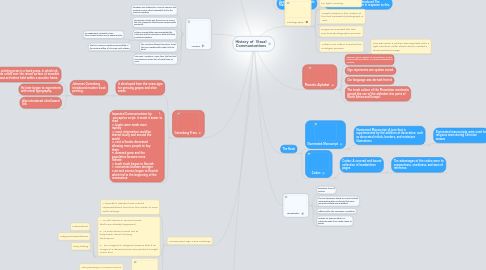
1. Cuneiform
1.1. The Sumerians created it to keep track of business transactions
1.1.1. They used wedge shaped stylus made from reeds to make impressions into the clay surface. Then they lay the clay tablets in the sun allowing them to dry and harden.
1.2. It's often called "wedge-shaped" language
1.3. Pictograms (pictorial or visual representation of an object)
2. 30,000 years ago Cave Paintings
2.1. A beautiful, detailed and colorful representations found on the inside of cave walls ceilings.
2.2. 1. To tell stories or recount event that have already happened 2. As instructional visual aid to help teach about hunting techniques 3. For magical or religious reasons that if an image of a desired event was painted it might come true.
2.2.1. instructional
2.2.2. religious/superstitious
2.2.3. story telling
2.3. Lascaux Cave
2.3.1. This painting is in France and is the most famous cave painting ever.
3. Gutenberg Press
3.1. It developed from the screw-type for pressing grapes and olive seeds.
3.1.1. Johannes Gutenberg introduced modern book printing.
3.1.1.1. A printing press is a hand press, in which ink was rolled over the raised surface of movable hand-set letters held within a wooden frame.
3.1.1.2. He later began to experiment with metal typography,
3.1.1.3. Also introduced oiled based link.
3.2. Impacted Communications by: !. perceptive script: it made it easier to read 2. books were made more rapidly 3. more information could be shared locally and around the world 4. cost of books decreased allowing more people to buy them 5. demand grew and the population became more literate 6. book trade began to flourish 7. economies became stronger 8.art and science began to flourish which led to the beginning of the renossaince.
4. Linotype
4.1. Clephane was looking for a way to improve the printing process which eventually led to the Linotype Machine
4.2. Chirstopher Sholes was the person to invent the only typewriter that became commercially successful.
4.3. Ottmar Margenthaler was approached by Clephane and his associate to help with their typsetting machine.
4.3.1. He suggested: casting the type form a metal matrix versus papier-mâché.
4.4. The Linotype allowed operators to set the type mechanically rather than by hand.
4.4.1. The first Linotype machine was installed in the printing office of The New York Tribune.
4.5. The name "Linotype" came form the fact that it produces an entire line of metal type an once.
5. Computers
5.1. Zuse invented the first freely programmable computer.
5.2. Howard Riken and Grace Hopper invented the March series of computers.
5.3. IBM developed the 18M701 EOPM Computer
5.4. ARPANET was the first Internet
5.4.1. Developed to protect the flow of information between military installations by creating a network of geographically separated computers.
5.5. Apple introduce the Apple Macintosh Computer
5.5.1. Bill Gates and Microsoft introduced The Windows Operating System in response to this.
6. Hieroglyphics
6.1. Egyptians form of writing
6.2. They're logograms which are visual symbols representing ideas or objects that were generally stylized and simplified.
6.3. Influenced by the Sumerians' Cuneiform.
6.4. Written on papyrus which is a substrate made from reeds native to Egypt
7. Phonetic Alphabet
7.1. Theories: Direct variation of hieroglyphics, or that it ties in with Cuneiform, or it was an independent creation.
7.2. Sign represents one spoken sound.
7.3. Our language was derived from it
7.4. The trade culture of the Phoenician merchants spread the use of the alphabet into parts of North Africa and Europe.
8. The Book
8.1. Illuminated Manuscript
8.1.1. Illuminated Manuscript: A text that is supplemented by the addition of decoration, such as decorated initials, borders, and miniature illustrations.
8.1.1.1. Illuminated manuscripts were used for religious texts during Christian masses
8.2. Codex
8.2.1. Codex: A covered and bound collection of handwritten pages
8.2.1.1. The advantages of the codex were its compactness, sturdiness, and ease of reference.
9. Photography
9.1. 4th Century Camera Obscura
9.1.1. Used as a way to observe light.
9.1.2. Later on shrunk into a portable box.
9.2. Derived from the Greek words for light a writing.
9.3. Joseph Niepce is the creator of the first successful photograph in 1827
9.4. Daguerre invented the first practical photographic process.
9.5. William Fox Talbot invented the Calotype process.
9.5.1. This was when a picture was exposed onto a light sensitive metal sheet, which created a direct positive image.
